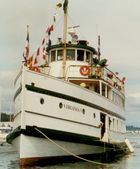Olympia, Washington
| City of Olympia | |
|---|---|
| — City — | |
 |
|
| Motto: SPIRIT - Service, People, Integrity, Results, Innovation, and Team | |
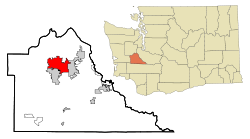 |
|
| Coordinates: | |
| Country | United States |
| State | Washington |
| County | Thurston |
| Incorporated | January 28, 1859 |
| Government | |
| - Mayor | Doug Mah |
| Area | |
| - Total | 18.5 sq mi (48.0 km2) |
| - Land | 16.7 sq mi (43.3 km2) |
| - Water | 1.8 sq mi (4.7 km2) |
| Elevation | 95 ft (29 m) |
| Population (2000) | |
| - Total | 42,514 |
| - Density | 1,181.3/sq mi (456.1/km2) |
| Time zone | Pacific (UTC-8) |
| - Summer (DST) | Pacific (UTC) |
| ZIP codes | 98500-98599 |
| Area code(s) | 360 |
| FIPS code | 53-51300[1] |
| GNIS feature ID | 1533353[2] |
| Website | www.olympiawa.gov |
Olympia is the capital city of the U.S. state of Washington and the county seat of Thurston County.[3] It was incorporated on January 28, 1859. The population was 42,514 at the 2000 census. Olympia is a major cultural center of the Puget Sound region.
Contents |
History
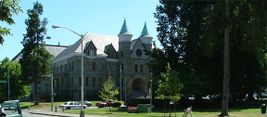
The site of Olympia was home to Lushootseed-speaking peoples for thousands of years, including Squaxin, Nisqually, Puyallup, Chehalis, Suquamish, and Duwamish. The first recorded visit by Europeans was in 1792 when Peter Puget and a crew from the British Vancouver Expedition charted the site.
In the 1840s, Edmund Sylvester and Levi Smith jointly claimed the land that now comprises downtown Olympia. In 1851, the U.S. Congress established the Customs District of Puget Sound for Washington Territory and Olympia became the home of the customs house. Its population being steadily expanded from Oregon Trail immigrants, in 1853 the town settled on the name Olympia, at the suggestion of local resident Colonel Isaac N. Ebey,[4] due to its view of the Olympic Mountains to the northwest. The area began to be served by a small fleet of steamboats known as the Puget Sound Mosquito Fleet.
In 1896, Olympia became the home of the Olympia Brewing Company, which brewed Olympia Beer until 2003.
A 1949 earthquake damaged many historic buildings beyond repair, and they were demolished. Parts of the city also suffered damage from earthquake tremors in 1965 and the 2001 Nisqually earthquake.
In 1967, the state legislature approved the creation of The Evergreen State College in Olympia. Because of the college's presence, Olympia has become a hub for artists and musicians, and was recently named one of the best college towns in the nation for its vibrant downtown and access to outdoor activities.[5]
Geography and climate
Olympia is located at (47.042418, -122.893077).[6]
According to the United States Census Bureau, the city has a total area of 18.5 square miles (48 km2), of which, 16.7 square miles (43 km2) of it is land and 1.8 square miles (4.7 km2) of it (9.77%) is water.
The city of Olympia is located at the southern end of Puget Sound on Budd Inlet. The Deschutes River estuary was dammed in 1951 to create Capitol Lake. Much of the lower area of downtown Olympia sits on reclaimed land. The cities of Lacey and Tumwater border Olympia.
The climate of Olympia is a Marine West Coast climate (Koppen Csb), though sometimes characterized as Mediterranean. Most of western Washington's weather is brought in by weather systems that form near the Aleutian Islands in Alaska. It contains cold moist air, which brings western Washington cold rain, cloudiness, and fog. November and December are Olympia's rainiest months. City streets, creeks, and rivers often flood during the months of November through February. Olympia averages 50.8 inches (1,290 mm) of precipitation per year and has a year-round average of 75% cloud cover. According to one MSNBC study, Olympia had more rainy days per year on average over the past 30 years than any city in the lower 48 states.[7]
Snow for the 1971-2000 period averaged 14.7 inches (37.3 cm), but the median was much lower, at 4.3 inches (10.9 cm).[8]
| Climate data for Olympia, Washington | |||||||||||||
|---|---|---|---|---|---|---|---|---|---|---|---|---|---|
| Month | Jan | Feb | Mar | Apr | May | Jun | Jul | Aug | Sep | Oct | Nov | Dec | Year |
| Source: NOAA [8] | |||||||||||||
Parks
Olympia has a wide array of public parks and nature conservation areas. The Woodard Bay Natural Resources Conservation Area is a 600-acre (2.4 km2) parcel that preserves more than 5 miles (8.0 km) of Puget Sound waterfront along the Woodard and Chapman bays of the Henderson Inlet. Percival Landing Park includes 0.9 miles of boardwalk along Budd Inlet, as well as a playground, picnic areas and a large open space. The Watershed Park is the site of the former water works for the city, and today features a loop trail with a large second-growth forest. Other parks include Priest Point Park, Burfoot Park and Yauger Park, which is home to one of Olympia's public skate parks including Friendly Grove which is nestled in a small Eastside Community. The Nisqually National Wildlife Refuge is located just outside of Olympia, as is the Capitol State Forest.
Artesian water
Olympia was historically dependent on artesian waters. Early settlers in Swantown and Tumwater used artesian springs for their main water supply. The artesian spring at Fourth Avenue and Main Street (now called Capitol Way) was the main community well where settlers gathered to socialize. The artesian well in the Diamond Parking lot at Fourth Avenue and Jefferson Street is active, located in the parking lot of The Manium (421 4th Street). Another still flows at the corner of Olympia Avenue and Washington Street in the Bigelow Neighborhood. The northeast end of Capitol Lake was the location of an artesian well until the construction of a new park that included changes to the shoreline. McAllister Springs, the main water source for Olympia, is fed by artesian wells, and the former Olympia Brewery is supplied by 26 artesian wells.[9]
In downtown Olympia, current efforts to preserve the use of artesian water at the one remaining public well has been the mission of H2Olympia: Artesian Well Advocates[5]
Demographics
| Historical populations | |||
|---|---|---|---|
| Census | Pop. | %± | |
| 1870 | 1,203 |
|
|
| 1880 | 1,232 | 2.4% | |
| 1890 | 4,698 | 281.3% | |
| 1900 | 3,863 | −17.8% | |
| 1910 | 6,996 | 81.1% | |
| 1920 | 7,795 | 11.4% | |
| 1930 | 11,733 | 50.5% | |
| 1940 | 13,254 | 13.0% | |
| 1950 | 15,819 | 19.4% | |
| 1960 | 18,273 | 15.5% | |
| 1970 | 23,111 | 26.5% | |
| 1980 | 27,447 | 18.8% | |
| 1990 | 33,729 | 22.9% | |
| 2000 | 42,514 | 26.0% | |
| Est. 2009 | 46,100 | 8.4% | |
As of the census[1] of 2000, there were 42,514 people, 18,670 households, and 9,968 families residing in the city. The population density was 2,544.4 people per square mile (982.3/km²). There were 19,738 housing units at an average density of 1,181.3/sq mi (456.1/km²). The racial makeup of the city was 85.26% White, 1.90% African American, 1.30% Native American, 5.82% Asian, 0.29% Pacific Islander, 1.68% from other races, and 3.76% from two or more races. Hispanic or Latino of any race were 4.38% of the population. 15.0% were of German, 11.3% Irish, 10.0% English, 6.0% Norwegian and 5.3% American ancestry according to Census 2000. 91.6% spoke English, 2.9% Spanish and 1.7% Vietnamese as their first language.
There were 18,670 households out of which 26.8% had children under the age of 18 living with them, 39.6% were married couples living together, 10.4% had a female householder with no husband present, and 46.6% were non-families. 35.2% of all households were made up of individuals and 10.7% had someone living alone who was 65 years of age or older. The average household size was 2.21 and the average family size was 2.88.
In the city the population was spread out with 21.5% under the age of 18, 11.9% from 18 to 24, 30.4% from 25 to 44, 22.9% from 45 to 64, and 13.3% who were 65 years of age or older. The median age was 36 years. For every 100 females, there were 91.5 males. For every 100 females age 18 and over, there were 88.1 males.
The median income for a household in the city was $40,846, and the median income for a family was $54,136. Males had a median income of $41,267 versus $31,515 for females. The per capita income for the city was $22,590. About 6.9% of families and 12.1% of the population were below the poverty line, including 10.4% of those under age 18 and 6.3% of those age 65 or over.
Capital of Washington State
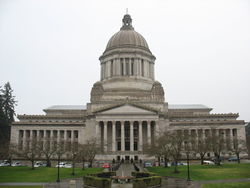
Olympia serves as the capital for the State of Washington. The bicameral Washington State Legislature is composed of a lower House of Representatives and an upper State Senate. The state is divided into 49 legislative districts of equal population, each of which elects two representatives and one senator. Representatives serve two-year terms, whilst senators serve for four years. There are no term limits. Currently, the Democratic Party holds majorities in both chambers.
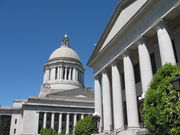
Washington's executive branch is headed by a governor elected for a four-year term. The current governor is Christine Gregoire, a Democrat who has been in office since 2005.
Schools and universities
Olympia's main public school district is the Olympia School District. Olympia School District enrolled 9,231 students in K-12, based on the 2005-06 school year enrollment report. The school district has a total of 18 schools: 11 elementary schools, 4 middle schools and 3 high schools. Its high schools are Olympia High School (originally known as William Winlock Miller High School), Capital High School, and Avanti High School.
In the 2007-2008 school year, Olympia began the new Parent Partnership Program, which provides more opportunities to homeschooling families. Olympia's online high school, Olympia Regional Learning Academy (ORLA), is also part of the same program. Private elementary schools include Olympia Waldorf School, Olympia Community School, St. Michael School, Holy Family, and Evergreen Christian. Private middle schools include NOVA Middle School.
In addition to primary & secondary schools, Olympia has a number of institutions of higher learning, including The Evergreen State College, South Puget Sound Community College, and St. Martin's University in adjacent Lacey, Washington.
Arts

Olympia is a regional center for fine arts. A number of theatrical experiences are available with companies such as Capital Playhouse, Olympia Family Theater, Theater Artists Olympia (TAO), Olympia Little Theater, and Harlequin Productions at the historic State Theater. The Olympia Symphony Orchestra performs five regular season concerts at the Washington Center and two pop concerts.
While there is no official art museum in Olympia, rotating exhibitions by regional artists as well as permanent installations from the Washington State collection can be viewed by appointment on tours of Art In Ecology at the Washington Department of Ecology headquarters, in the neighboring city of Lacey. Art In Ecology primarily presents works by northwest artists. The range of work is diverse, with an emphasis on ecological and socially themed bodies of work. Permanent installations by Alfredo Arreguin, including a large stained glass mural called "The Froth" grace the main lobby. Nearby is a large tapestry designed by San Francisco based Roy DeForest. An hour long tour will give one to see works by 20-25 regional artists.
A lively range of visual art venues include some of the local coffeehouses, such as Batdorf & Bronson and Caffe Vita in downtown. Murals and public art installations of sculpture are prevalent in Olympia, and are especially featured on the State Capitol Campus and along Percival Landing on the urban waterfront. At the Evergreen State College, an art gallery is located in the Daniel Evans Library Building. South Puget Sound Community College has a gallery in its Minnaert Center with rotating exhibitions. The Washington Center for the Performing Arts also presents visual art exhibitions throughout the season in the spacious lobby areas.
Each year the Olympia Film Society (OFS) produces a nationally-recognized film festival and fosters film and video education in Olympia. It also shows independent, classic and international films year-round at the art-deco Capitol Theater. A mostly volunteer-powered organization, OFS supports and presents a variety of culture events, including All Freakin' Night, an all-night horror film screening with a cult following.
On the fourth Saturday in April, in honor of Earth Day, Olympia is host to one of the region's largest community celebrations - the Procession of the Species celebration. Held in conjunction with the city's biannual Arts Walk, the Procession is organized by the community-based non-profit organization, Earthbound Productions. Structured around an annual Community Art Studio that is free and open to the public, organizers provide art, music and dance workshops during the preceding seven weeks leading up to the Procession weekend.[10] In its July 2009 Best of America feature, Reader's Digest magazine honored the Procession of the Species with the top spot in its “can’t resist” parades and processions list.[11][12] Open to all, the Procession of the Species attracts up to 30,000 viewers, while its costumed participants of all ages frequently number nearly 3,000. Musicians and samba dancers enliven the movements from a full spectrum of community members, all moving joyously in creative motorless floats and costumed as the elements and various species of the earth. On the Friday evening before the Procession of Species, a Luminary Procession is held at night in honor of the spirit of life that connects all to the miracle of the natural world.
Sports
Olympia is the home of the Oly Rollers, the local women's flat track roller derby league whose travel team (the Cosa Nostra Donnas) became the 2009 national champions of the Women's Flat Track Derby Association (WFTDA) by winning the national "Declaration of Derby" tournament in Philadelphia, PA on November 15, 2009.[13]
Transportation
Rail
Amtrak, the national passenger rail system, provides service to Olympia-Lacey at Centennial Station. Amtrak train 11, the southbound Coast Starlight, departs Olympia at 11:21am with service to Centralia; Portland; Sacramento; Emeryville, California (with bus connection to San Francisco); and Los Angeles. Amtrak train 14, the northbound Coast Starlight, departs Olympia at 6:22pm daily with service to Tacoma and Seattle. Amtrak Cascades trains, operating as far north as Vancouver and as far south as Eugene, Oregon, serve Olympia-Lacey several times daily in both directions.
Bus
Olympia, Lacey, Tumwater, and the surrounding area are primarily served by Intercity Transit. Routes from other transit services such as Grays Harbor Transit, Mason Transit, and the Tacoma/Lakewood Express with Pierce Transit. Intercity Transit maintains a free shuttle route called "Dash"[14]. Dash runs from the Capitol Campus to the Farmers Market at the far edge of downtown.
Famous residents
The 90s riot grrrl feminist punk movement, (including bands like Bikini Kill and Bratmobile), is from Olympia.
The band Sleater-Kinney, which has its origins in the riot grrrl scene is from Olympia and took its name from Sleater Kinney Road, which briefly passes through the eastern part of the city. Kurt Cobain wrote most of Nirvana's Nevermind album while living in Olympia.
Kimya Dawson is also a resident of Olympia.
Novelist Caitlin Kittredge resides in Olympia.
A number of influential politicians have also lived in Olympia, due to its position as the capital of Washington.
The Fleetwoods were a very popular group in the 50's and all three of them were from Olympia. Gary Troxel & Gretchen Christopher went to Olympia High and Barbara Ellis went to North Thurston High. Their very famous Mr. Blue was on the charts for a goodly time.
Sister cities
Olympia has one sister city – Katō, Japan. There were previous agreements with Olympia, Greece and Samarkand, Uzbekistan but these are no longer in effect.[15]
Fictional references
Master pulp fiction writer Raymond Chandler once sent his pre-Philip Marlowe sleuth Carmady to Olympia, in 1936 set short story "Goldfish". Depression-era town with government buildings sketchily described. The yarn ends violently on the extreme tip of Olympic Peninsula, in prohibition time, a smugglers' nest, in Westport.
Influences to music
The Olympia independent record label K Records is legendary in indie music circles. Olympia was the heart of the '90s punk riot grrrl movement, and to the band Sleater-Kinney which hailed from that scene.
The band Hole wrote and recorded a song called "Olympia" (aka "Rock Star") on their album Live Through This (1994).
Olympia was also the heart of the '90s queercore scene, with bands such as the Mukilteo Fairies and Team Dresch calling it home.
The band Rancid wrote and recorded a song called "Olympia, WA" on their album ...And Out Come the Wolves (1995); this song was later covered by the bands NOFX (2003) and Rentokill (2004).
Nirvana lived in Olympia; Kurt Cobain wrote most of the songs released on Nevermind while living in an apartment on Pear Street in Olympia.
Modest Mouse recorded their first full-length album This Is a Long Drive for Someone with Nothing to Think About in Olympia.
See also

- The Evergreen State College - Higher education institution in Olympia
- Capitol Lakefair - Annual festival in Olympia
- Olympia Airport - Located in Tumwater
- Capital City Pride - Community Gay, Lesbian, Bisexual and Transgendered (GLBT) Festival
- CommonAction - Nonprofit organization located in Olympia
- Olympia music scene
- Music of Washington
- Cascadia
- Port Militarization Resistance
- Bigelow Neighborhood
- Bigelow House
- Olympia High School (Washington)
- Capital High School (Washington)
- Procession of the Species
References
- ↑ 1.0 1.1 "American FactFinder". United States Census Bureau. http://factfinder.census.gov. Retrieved 2008-01-31.
- ↑ "US Board on Geographic Names". United States Geological Survey. 2007-10-25. http://geonames.usgs.gov. Retrieved 2008-01-31.
- ↑ "Find a County". National Association of Counties. http://www.naco.org/Template.cfm?Section=Find_a_County&Template=/cffiles/counties/usamap.cfm. Retrieved 2008-01-31.
- ↑ http://www.ci.olympia.wa.us/en/community/about-olympia.aspx
- ↑ (2003) Outside Magazine.
- ↑ "US Gazetteer files: 2000 and 1990". United States Census Bureau. 2005-05-03. http://www.census.gov/geo/www/gazetteer/gazette.html. Retrieved 2008-01-31.
- ↑ And the rainiest city in the U.S. is...
- ↑ 8.0 8.1 "NCDC: U.S. Climate Normals". National Oceanic and Atmospheric Administration. http://cdo.ncdc.noaa.gov/climatenormals/clim20/wa/456114.pdf. Retrieved 2010-05-14.
- ↑ Friends of Artesians. ""Historic locations."". http://www.oly-wa.us/Artesians/Historic.php. Retrieved 2007-07-02.
- ↑ About the Community Art Studio — Official Website of the Procession of the Species. Retrieved October 16, 2009.
- ↑ Procession of the Species tops Readers Digest list — June 22, 2009. The Olympian. Retrieved October 16, 2009.
- ↑ 8 People, Places and Things We Love About America — Reader's Digest Website. Retrieved October 16, 2009.
- ↑ http://www.derbynewsnetwork.com/2009/11/2009_nationals_capsule_recaps
- ↑ Dash
- ↑ Information on Olympia's former sister cities
External links
- City of Olympia
- Thurston County Chamber of Commerce
- Olympia Historical Society
- Olympia, Washington at the Open Directory Project
|
||||||||||||||||||||||||||||||||||||||||||||||||||||||||||||||||||||||||||||||||||||||||||||||
|
|||||||||||||||||||||||||||||||||||||||||||||||||||||||||||||||||||||||||||||||||||||||||||||||||||||||||||||||||||||||||||||||

